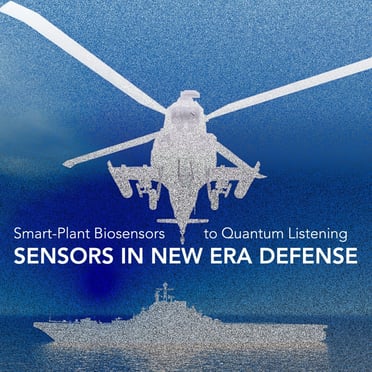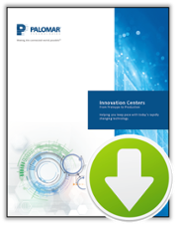One of the great shifts currently taking place in global defense sensor technologies, is due to a fundamental realignment of military strategies, itself brought about by the convergence of a number of critical megatrends; long-term COVID-19 endemic management; rising geo-political competition; the rapid evolution of advanced technologies; new wafer level packaging providing for ubiquity; mass digitization; advances in computational application; the prospect of quantum processing; ever higher levels of artificial intelligence or AI; the unleashing of inventiveness brought about by current necessities; and finally, the way in which these different factors have interacted with each other. Any sense that this list points to marked and exponentially increasing rate of change—and challenge—should be taken at face value.
 What especially needs underscoring is AI. So easy to dismiss as merely “advanced software”, a much more accurate understanding is to see it as analogous to the insertion of electric power into a previously dominant age of steam. Electrification not only led to a rapid rise in efficiency using the same physical processes, but an explosion in new applications. An explosion that because of zero carbon policies, has greater implications for contemporary development today, than ever. In short, AI must be viewed as facilitating a very significant succession of evolutionary technical advances we are only just beginning to practically apply—with sensors at the center of it all.
What especially needs underscoring is AI. So easy to dismiss as merely “advanced software”, a much more accurate understanding is to see it as analogous to the insertion of electric power into a previously dominant age of steam. Electrification not only led to a rapid rise in efficiency using the same physical processes, but an explosion in new applications. An explosion that because of zero carbon policies, has greater implications for contemporary development today, than ever. In short, AI must be viewed as facilitating a very significant succession of evolutionary technical advances we are only just beginning to practically apply—with sensors at the center of it all.
AI is empowering to a large number of distinct, yet highly integrated ecosystems, drawing them upwards on a seemingly endless trajectory of ever deepening synergy; being able to do more with less; more with more; drawing ultra tech into the mainstream; and exploiting physical laws and biological properties in a way that were once the preserve of science fiction. Examples here include sensors that are able to see around corners, quantum-based devices capable of analyzing the full spectrum of real-world signals, and bio-engineered plants that change color when exposed to certain chemicals (such as toxins or explosive residues). These typify the use of sensors to achieve huge advances in surveillance, more secure communications, eavesdropping into Bluetooth and Wi-Fi, as well as providing unparalleled sensitivity and accuracy. Such heightened capabilities, are, in many ways, the essence of military operations, namely, stealth, detection, action: “I don’t want you to see what I am doing; but I do want to see what you are doing”. Equally, “I want to see better what I am doing”.
At this juncture, a second element that needs to be underscored are the advantages that come from recent developments in sensor diversity and subsequent multiple source data integration. In terms of explaining the practical value, perhaps the best analogy is the invention of stereo audio. A profoundly simply idea (a second, tactically placed, microphone and speaker), yet for over a century now the result amazed and still amazes listeners, as the spatial placement of sound in home cinemas moves to ever higher levels of refinement and enjoyment (all coming from the addition of more speakers). The simile is presented to give the reader a tool by which he or she may begin to grasp the huge potential that the use of multiple types of sensor is both yielding, together with the almost limitless use to which the technical principle may yet be put.
Indeed, at the time of writing, a first-of-its-kind technology is being developed that will leverage multiple data sources using advanced data fusion algorithms, adversary modeling, pattern matching, and machine learning techniques to detect and identify indications of chemical, biological, radiological, nuclear and explosive threat, and do so on a real time global scale.
As has been implied, the marked increase in sensor utilization within defense is in part an outflow of the technology’s own inherent evolution, and, in part, a reaction to advances in technology elsewhere. A good example of the former is how the development of autonomous drive has yielded very much more advanced sensing capabilities, at significantly reduced cost, especially in terms of truly comprehensive “vision” and machine learning (not least in the area of object recognition). For the military, the result has been the very rapid development of military drones (lower end) and RPSA or Remotely Piloted Air Systems (higher end). Indeed, as far as drones are concerned, one strategy is for these to be deployed on the world’s aircraft carriers as literal swarms, replacing some jet fighter capability. An example of external pressures on sensor technology development is to meet the challenges of hypersonic missiles. The issue here is not only speed, but also trajectory, faster and lower. In short, these missiles very significantly reduce detection time, and so both warning and response options. Another challenge is to meet the need for more secure, lower latency, increasingly failsafe, communication of sensor data. Finally, these various trends, together with rising levels of geo-political competition and growing potential grey-zone tensions, make critical the development of effective countermeasures against these very same advances, for example, knocking out unfriendly drones or interrupting sensor operation and the communication of data.
More challenging still, has been the shift in thinking as regards the most likely arenas of future tension, thinking that has veered very sharply in a Maritime direction. Control of the seas, control of areas of sea, and the ability to project power from the sea, seems to be been universally judged the most strategic response to the current realignment of big power hegemony. Critical to navel safety and effectiveness are a range of sensors that provide day-night, long-range, accurate detection, that concomitantly support weapon engagement, as equally high levels of sea-based, friend/foe situational awareness. The latter especially is pushing the development of a range of non-acoustic sensors (such as those detecting chemical or nuclear residues). Either way, all these sensors require varying levels of environmental protection. Some of these will be high-end, ultra-cooled, highly protected devices, but the majority will be small and lightweight (as befits remote or autonomous air and sea systems) yet with high quality, dependable detection range and coverage. The critical word here is “yet”. Historically, sensors have been small and lightweight or ultra-high ability. Bridging the gap between the two exactly represents the defining activity on today’s military and security sensor roadmap, indeed, the entire sector as a whole.
Currently the global defense procurement ecosystem is undergoing a ping-pong push between governments demanding Silicon Valley levels of business and technical development, and leading defense contractors hungry to prove new energies in inventiveness and commercial cognizance. Palomar Technologies’ response to this dynamic is the continued development of the company’s three Innovation Centers in California, Singapore and the UK. Capitalizing on cluster energies in each case, these centers not only enable Palomar to participate in developing some of the new packaging technologies that serve defense and other high-grade sensor ecosystems, but provide our customers with vital local access to develop processes with us, in person or digitally, either way, in a similar time zone and sufficiently close to facilitate rapid physical prototyping, product sampling or testing.
Learn more about our Demonstration Lab at EPIC in the UK here. Also, download these additional resources for more:
----
Dr. Anthony O'Sullivan
Palomar Technologies
Strategic Market Research Specialist

